Androids in the Media: A Continuation
It is a well known fact that the concept of artificial intelligence has gained increasing popularity over the years. Artificial intelligence includes, but is not limited to, robots, androids and cyborgs. In my third paper for this class, I gave three examples of androids depicted in movies and TV shows and discussed the implications of those depictions. As there are a lot more reasons for the hype surrounding artificial intelligence, I chose to further delve into it. I have again restricted my research to androids but have looked at examples chronologically over the past one hundred and thirty years to see what different time periods have thought about artificial intelligence and also what that says about us.
The word ‘android’ is derived from androides which comes from the Greek words andro– meaning ‘man’ and –eides meaning ‘form or shape’. Despite having a gender-specific root, the word ‘android’ is used in a gender neutral context (Wikipedia – Android). According to the Oxford English Dictionary, an android is an automaton resembling a human being. On looking up the definition of an automaton, two possible explanations seemed relevant to me. They are ‘a living being whose actions are purely involuntary or mechanical’ and ‘a human being acting mechanically or without active intelligence in a monotonous routine’. The latter definition of an automaton suggests that androids do not have the ability to completely resemble humans in all aspects as they lack the cognitive abilities responsible for human emotion and being able to perceive and respond to body language, subtle meanings behind words and social cues. Also, they may have skin and blood, which are organic, but these do not affect the working of the skeleton and internal systems of the androids, which are completely mechanical. This feature distinguishes androids from cyborgs, organisms that have symbiotic natural and artificial systems.
The first example I picked is a novel published in 1886 called L’Ève future or The Future Eve or Tomorrow’s Eve by Auguste Villiers de l’Isle-Adam. A significant note about this novel is that it is responsible for popularizing the term ‘android’.
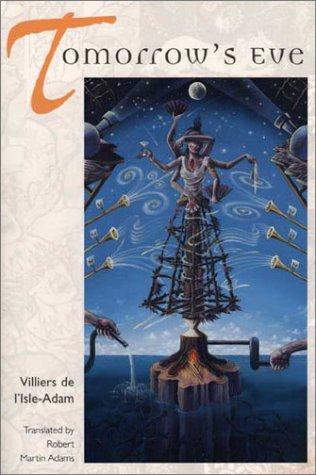 The story features a fictionalized Thomas Edison who is visited by a friend, Lord Ewald. Lord Ewald confesses to Edison that he is in despair and is seriously thinking of killing himself because of his fiancée, Miss Alicia Clary. Alicia is described as “being physically perfect but emotionally and intellectually empty” with all her actions and words guided by other people’s expectations and desires and not her own (Wikipedia – The Future Eve). Ewald loves her dearly and is sure that he cannot love anyone else. However, he is so upset by the difference between her physical appearance and her actual personality that he feels the only solution left is to kill himself. Edison provides an alternative – he introduces Ewald to his android, named Hadaly, and says that he can turn Hadaly into a better version of Alicia i.e. he can give Hadaly Alicia’s appearance but not give it any of the personality traits that bother Ewald. Ewald accepts after learning more about Edison’s plans for the project. In order to convince Ewald, Edison explains “how [Ewald] will interact with the android … how she moves and talks and breathes and bathes, all the while explaining how natural and normal Hadaly’s robotic needs are, comparing them to similar human actions and functions” (Wikipedia – The Future Eve). This remark implies that Edison’s artificial creation, which was modeled on a ‘real’ human woman, would feel more natural and pleasant to a man that its human counterpart. An even more intriguing piece of this story is Edison’s reason for creating Hadaly. He got the inspiration to create it when he found out that Mr. Edward Anderson, a married man, was being pursued by a young woman named Miss Evelyn and that he was unfaithful to his wife because of her. Moreover, it was due to Miss Evelyn that his infidelity was found out leading him to commit suicide. On visiting Miss Evelyn, Edison was shocked to find that her physical beauty was a façade masking her true, ugly physical self. She was able to transform her physical appearance by using products like wigs, cosmetics and false teeth among others. In his narration of the story, we see that Edison loathes Miss Evelyn as he believes her to be the embodiment of all that is evil in a female (Goulet, 216). His justification for creating Hadaly then is her “lack of pretence about her very artificiality” (Goulet, 220). This lack of pretence enables Hadaly, an artificial being, to be more honest about herself and more ‘natural’.
The story features a fictionalized Thomas Edison who is visited by a friend, Lord Ewald. Lord Ewald confesses to Edison that he is in despair and is seriously thinking of killing himself because of his fiancée, Miss Alicia Clary. Alicia is described as “being physically perfect but emotionally and intellectually empty” with all her actions and words guided by other people’s expectations and desires and not her own (Wikipedia – The Future Eve). Ewald loves her dearly and is sure that he cannot love anyone else. However, he is so upset by the difference between her physical appearance and her actual personality that he feels the only solution left is to kill himself. Edison provides an alternative – he introduces Ewald to his android, named Hadaly, and says that he can turn Hadaly into a better version of Alicia i.e. he can give Hadaly Alicia’s appearance but not give it any of the personality traits that bother Ewald. Ewald accepts after learning more about Edison’s plans for the project. In order to convince Ewald, Edison explains “how [Ewald] will interact with the android … how she moves and talks and breathes and bathes, all the while explaining how natural and normal Hadaly’s robotic needs are, comparing them to similar human actions and functions” (Wikipedia – The Future Eve). This remark implies that Edison’s artificial creation, which was modeled on a ‘real’ human woman, would feel more natural and pleasant to a man that its human counterpart. An even more intriguing piece of this story is Edison’s reason for creating Hadaly. He got the inspiration to create it when he found out that Mr. Edward Anderson, a married man, was being pursued by a young woman named Miss Evelyn and that he was unfaithful to his wife because of her. Moreover, it was due to Miss Evelyn that his infidelity was found out leading him to commit suicide. On visiting Miss Evelyn, Edison was shocked to find that her physical beauty was a façade masking her true, ugly physical self. She was able to transform her physical appearance by using products like wigs, cosmetics and false teeth among others. In his narration of the story, we see that Edison loathes Miss Evelyn as he believes her to be the embodiment of all that is evil in a female (Goulet, 216). His justification for creating Hadaly then is her “lack of pretence about her very artificiality” (Goulet, 220). This lack of pretence enables Hadaly, an artificial being, to be more honest about herself and more ‘natural’.
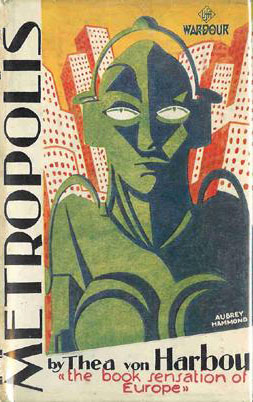 In the 1927 movie Metropolis directed by Fritz Lang, a scientist named Rotwang creates a robot that resembles his former lover Hel. Just after finishing the robot, the creator of the city Metropolis, Johann Fredersen, approaches him for help regarding a possible problem the workers of the city may pose. Hel had left Rotwang for Fredersen and had died giving birth to Fredersen’s son, Freder. After seeing the robot Hel, Fredersen persuades Rotwang to give the robot the appearance of Maria, the workers’ guiding force, so that she can persuade them to not revolt against him and destroy his work. Because of his jealousy of Fredersen and his bitterness at Hel leaving him and then her dying, Rotwang agrees to change Hel to Maria for ulterior motives – to destroy Fredersen by destroying everything he cherished – his son and his city.
In the 1927 movie Metropolis directed by Fritz Lang, a scientist named Rotwang creates a robot that resembles his former lover Hel. Just after finishing the robot, the creator of the city Metropolis, Johann Fredersen, approaches him for help regarding a possible problem the workers of the city may pose. Hel had left Rotwang for Fredersen and had died giving birth to Fredersen’s son, Freder. After seeing the robot Hel, Fredersen persuades Rotwang to give the robot the appearance of Maria, the workers’ guiding force, so that she can persuade them to not revolt against him and destroy his work. Because of his jealousy of Fredersen and his bitterness at Hel leaving him and then her dying, Rotwang agrees to change Hel to Maria for ulterior motives – to destroy Fredersen by destroying everything he cherished – his son and his city.
Rotwang calls the robot Maschinenmensch or Machine-Man yet the robot does not look like a man. Thea von Harbou, who wrote the novel Metropolis in 1927 and the screenplay for the movie, described the robot in the book as “a very delicate, but faceless, transparent figure made of crystal flesh with silver bones and its eyes filled with an expression of calm madness” (Wikipedia – Maschinenmensch).  However, Rotwang also calls the robot Futura, Parody and Delusion because he says these are characteristics of a woman. The movie further shows the robot’s feminine aspects by giving it a woman’s figure with high cheekbones, breasts and a narrow waist. The novel depicts the robot as perfectly obedient and once given a human woman’s appearance, it can be the ultimate temptress and lead men to their doom (Wikipedia – Maschinenmensch). The android Maria in the movie accomplishes this when she acts as an exotic dancer at the Yoshiwara nightclub. Her erotic moves cause the men present to become half-mad with desire resulting in numerous fights among themselves as to who can have her. In following her orders from Rotwang, we see that android Maria ‘loses control’ and goes on a rampage. She instigates the workers to destroy the machines that run the city, all the while becoming more and more ‘wild’. In ruining the machinery, the workers’ homes are destroyed and the workers’ children would have been killed if it weren’t for Freder, the actual Maria and a foreman at the plant. At the end, when the workers and their wives catch android Maria, thinking it is the real Maria, and burn it at the stake for supposedly leading them to kill their children, we see it laughing maniacally before its skin is burnt off to show the actual robot.
However, Rotwang also calls the robot Futura, Parody and Delusion because he says these are characteristics of a woman. The movie further shows the robot’s feminine aspects by giving it a woman’s figure with high cheekbones, breasts and a narrow waist. The novel depicts the robot as perfectly obedient and once given a human woman’s appearance, it can be the ultimate temptress and lead men to their doom (Wikipedia – Maschinenmensch). The android Maria in the movie accomplishes this when she acts as an exotic dancer at the Yoshiwara nightclub. Her erotic moves cause the men present to become half-mad with desire resulting in numerous fights among themselves as to who can have her. In following her orders from Rotwang, we see that android Maria ‘loses control’ and goes on a rampage. She instigates the workers to destroy the machines that run the city, all the while becoming more and more ‘wild’. In ruining the machinery, the workers’ homes are destroyed and the workers’ children would have been killed if it weren’t for Freder, the actual Maria and a foreman at the plant. At the end, when the workers and their wives catch android Maria, thinking it is the real Maria, and burn it at the stake for supposedly leading them to kill their children, we see it laughing maniacally before its skin is burnt off to show the actual robot.
 The third example I draw on is the Terminator series, the first movie being released in 1984 and the latest movie being released on the 21st of May, 2009. The Terminator is widely known as being a cyborg but in actuality, it is an android as its skin and blood serve as a disguise and do not have a symbiotic relationship with the mechanical systems of the Terminator. In the later movies, it is clearly seen that the mechanical endoskeleton of the Terminator is fully functional when independent of the organic systems (Wikipedia – Cyborgs in Fiction). In the movies and TV series, we see how the androids are physically stronger than humans and also how newer models are faster and stronger than the older ones.
The third example I draw on is the Terminator series, the first movie being released in 1984 and the latest movie being released on the 21st of May, 2009. The Terminator is widely known as being a cyborg but in actuality, it is an android as its skin and blood serve as a disguise and do not have a symbiotic relationship with the mechanical systems of the Terminator. In the later movies, it is clearly seen that the mechanical endoskeleton of the Terminator is fully functional when independent of the organic systems (Wikipedia – Cyborgs in Fiction). In the movies and TV series, we see how the androids are physically stronger than humans and also how newer models are faster and stronger than the older ones.
In Terminator, a T-100 (portrayed by Arnold Schwarzenegger) is sent back in time to 1984 to kill Sarah Connor, whose future son John will become the leader of the human resistance against the androids. A human from the future, Kyle Reese, also arrives in 1984 to protect Sarah Connor. “The Terminator feels no pain, has no emotions, and will stop at nothing to accomplish its mission” (Wikipedia – The Terminator). Thus the terminator here and in the rest of the movies do not display variety in facial expressions and are able to continue whatever it was they were doing almost regardless of the extent of damage they undergo.
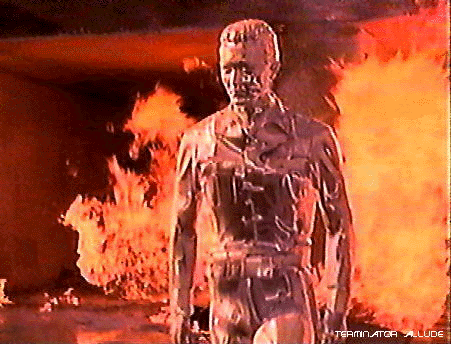 The second movie, Terminator 2: Judgment Day, is set around ten years after the events in the first film. We find Arnold Schwarzenegger playing a replica of himself that is now programmed to protect 10 year old John Connor and follow his orders. The terminator that is sent back to kill John Connor is a newer model, the T-1000, which is made completely of liquid metal. This allows it to mold parts of itself or its complete form into a new physical appearance thereby giving it more opportunities to blend into the human world. However, it mostly remains in a male form (played by Robert Patrick) until it molds itself to look like Sarah Connor. An interesting development that is seen in this movie is the Terminator beginning to understand human emotion as it bonds with young John. After destroying the T-1000 at the end of the film, the Terminator tells the Connors to destroy him too so that his technology will not be available for studying and replicating. By this time, John has grown attached to the Terminator and begs him to stay but the Terminator, while revealing “a newfound understanding of human emotion” insists on being destroyed (Wikipedia – Terminator 2: Judgment Day). This gives Sarah Connor hope that humanity has a chance of survival in the future for “if a machine, a Terminator, can learn the value of human life, maybe we can too” (Wikipedia – Terminator 2: Judgment Day).
The second movie, Terminator 2: Judgment Day, is set around ten years after the events in the first film. We find Arnold Schwarzenegger playing a replica of himself that is now programmed to protect 10 year old John Connor and follow his orders. The terminator that is sent back to kill John Connor is a newer model, the T-1000, which is made completely of liquid metal. This allows it to mold parts of itself or its complete form into a new physical appearance thereby giving it more opportunities to blend into the human world. However, it mostly remains in a male form (played by Robert Patrick) until it molds itself to look like Sarah Connor. An interesting development that is seen in this movie is the Terminator beginning to understand human emotion as it bonds with young John. After destroying the T-1000 at the end of the film, the Terminator tells the Connors to destroy him too so that his technology will not be available for studying and replicating. By this time, John has grown attached to the Terminator and begs him to stay but the Terminator, while revealing “a newfound understanding of human emotion” insists on being destroyed (Wikipedia – Terminator 2: Judgment Day). This gives Sarah Connor hope that humanity has a chance of survival in the future for “if a machine, a Terminator, can learn the value of human life, maybe we can too” (Wikipedia – Terminator 2: Judgment Day).
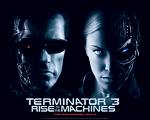 Terminator 3: Rise of the Machines is set about eight years after the events in the previous movie. We find that another newer terminator, the T-X, is sent back in time to kill John Connor, his future wife Kate, and as many of his future associates as possible. The T-X is given a female appearance here and is played by Kristanna Loken. The T-X is even more deadly than the previous terminators sent as it carries future weaponry within its body and has the ability to remotely control most machines. Once again, a reprogrammed Terminator identical to the ones seen in the previous movies has been sent from the future to protect John and destroy the T-X. I find it intriguing that their choice for the most deadly terminator yet was to be in the form of a woman. I don’t know if it is a deliberate statement on the idea of femininity or whether the movie-makers wanted to add more variety to the plot. Also, up until now, we have seen an android male attack (in the first movie), an android male protect humans from another android male, and an android man protect humans from an android woman.
Terminator 3: Rise of the Machines is set about eight years after the events in the previous movie. We find that another newer terminator, the T-X, is sent back in time to kill John Connor, his future wife Kate, and as many of his future associates as possible. The T-X is given a female appearance here and is played by Kristanna Loken. The T-X is even more deadly than the previous terminators sent as it carries future weaponry within its body and has the ability to remotely control most machines. Once again, a reprogrammed Terminator identical to the ones seen in the previous movies has been sent from the future to protect John and destroy the T-X. I find it intriguing that their choice for the most deadly terminator yet was to be in the form of a woman. I don’t know if it is a deliberate statement on the idea of femininity or whether the movie-makers wanted to add more variety to the plot. Also, up until now, we have seen an android male attack (in the first movie), an android male protect humans from another android male, and an android man protect humans from an android woman.
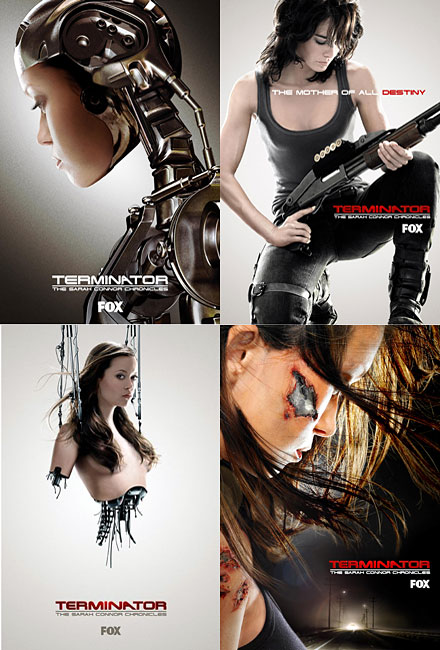 In the Terminator: The Sarah Connor Chronicles however, we see an android woman, Cameron, protecting the humans from being killed. This TV series is set after the second Terminator movie, in the year 1999. John and Sarah Connor are fugitives on the run from terminators sent from the future and law enforcers in the present. Sarah, John and Cameron are the principle actors in this series and can all be seen as having strong, tough personalities, which they need in order to survive.
In the Terminator: The Sarah Connor Chronicles however, we see an android woman, Cameron, protecting the humans from being killed. This TV series is set after the second Terminator movie, in the year 1999. John and Sarah Connor are fugitives on the run from terminators sent from the future and law enforcers in the present. Sarah, John and Cameron are the principle actors in this series and can all be seen as having strong, tough personalities, which they need in order to survive.
The final example I chose is A.I. Artificial Intelligence, a science fiction film that was released in 2001. This movie features androids called ‘mechas’ that are capable of experiencing human love and emotion. The focus of the movie is on an advanced prototype, David, who is given the form of a young boy. David is given to the Swintons whose son is placed in suspended animation while a cure for his rare disease is being looked for.  A special bond develops between the mother, Monica Swinton, and David. Monica is initially unsure as to how to treat him but she somehow activates David’s imprinting protocol. This results in David unconditionally loving her as a child loves a parent. And with such love, Monica finds herself loving him too just as if he were a real boy. Due to circumstances, Monica has to abandon David in a forest so that he can escape persecution and being destroyed. Monica is devastated at having to do this and David doesn’t fully comprehend why she leaves him and Teddy, his mecha bear, alone. He sets off to find the Blue Fairy from the tale of Pinocchio because he decides that if he can become a real boy, Monica will love him again and take him back. That hope is the one thing that keeps him going, which resembles a human boy’s belief and hope. He eventually finds the Blue Fairy, which is an amusement park statue. However David thinks that the statue is real and so he wishes to be a real boy, over and over again, for two thousand years. At the end of the film, Monica is recreated for a day and David spends the happiest hours of his life with her. She tells him before she goes to sleep for the final time that she loves him and has always loved him. After hearing the words that he had been hoping for for so long, David finally fell asleep, content as a human boy could be (Wikipedia – A.I. Artificial Intelligence).
A special bond develops between the mother, Monica Swinton, and David. Monica is initially unsure as to how to treat him but she somehow activates David’s imprinting protocol. This results in David unconditionally loving her as a child loves a parent. And with such love, Monica finds herself loving him too just as if he were a real boy. Due to circumstances, Monica has to abandon David in a forest so that he can escape persecution and being destroyed. Monica is devastated at having to do this and David doesn’t fully comprehend why she leaves him and Teddy, his mecha bear, alone. He sets off to find the Blue Fairy from the tale of Pinocchio because he decides that if he can become a real boy, Monica will love him again and take him back. That hope is the one thing that keeps him going, which resembles a human boy’s belief and hope. He eventually finds the Blue Fairy, which is an amusement park statue. However David thinks that the statue is real and so he wishes to be a real boy, over and over again, for two thousand years. At the end of the film, Monica is recreated for a day and David spends the happiest hours of his life with her. She tells him before she goes to sleep for the final time that she loves him and has always loved him. After hearing the words that he had been hoping for for so long, David finally fell asleep, content as a human boy could be (Wikipedia – A.I. Artificial Intelligence).
These examples that I have presented give a wide range of conclusions that can be drawn about human beings, humanity and how we perceive ourselves. A conclusion I had come to in a previous paper was that creating artificial mechanisms piece by piece, with the end products having the ability to think for themselves, gives humans the feeling of a god-like power. This is different from the human process of giving birth where involuntary biological processes are dominant. The urge to know whether artificial intelligence is possible to produce is one of the reasons why stories about robots, androids and cyborgs have gotten increasingly popular over the past century. However, it personally seems like a volatile experiment when you don’t know for sure what the outcome is going to be, especially if those creations turn on you and can destroy you. So what other motives are there for wanting to create such beings? One answer is that in trying to replicate humans, we come to understand and appreciate the physical, mental, psychological and emotional workings of humans better during and after the creation process. And perhaps this is experimentation on whether we can create beings without human follies and weaknesses, if we can create ‘better’ versions of ourselves. Artificial beings will never be tempted to do the ‘wrong’ thing (say, choosing between doing homework and procrastinating) if they’re programmed correctly and they’re not given free will. Unfortunately, this leads to the confusing question of whether free will is an essential part of being human or whether everything is predestined and we are powerless to change our paths.
Leaving that question aside, we see depictions of androids wanting to become human (for example, David in A.I. and Data in Star Trek: The Next Generation) and make ‘illogical’ decisions that are emotionally controlled. I am unsure as to how to interpret this. Maybe it implies that being around humans long enough, the curiosity to see why humans behave the way they do increases and the robots want to experience this for themselves. Perhaps it’s saying that being in human company, becoming or at least wanting to become human and experience emotions is inevitable. Maybe this means that our hopes of creating something ‘better’ can’t be realized this way.
An interesting point to note is that in all the examples depicted (except the Hadaly case), we see how actual humans portray robots that portray humans. This adds a layer of complexity to the story that is being told in that the actors have to act as machines that are trying to pass as human. Summer Glau, who plays the terminator Cameron in Terminator: The Sarah Connor Chronicles said that “she was “intimidated” by the role because it was a challenge for her to balance the human and robot characteristics” (Wikipedia – Terminator: The Sarah Connor Chronicles). Haley Joel Osment, who played David in A.I., made sure to have good posture and not to blink his eyes in his efforts of portraying a robot human (Wikipedia – A.I. Artificial Intelligence). In playing the android Maria in Metropolis, actress Brigitte Helm “wore heavy makeup and her expressions, gestures, and poses were strongly exaggerated compared to Maria’s normally very composed and demure demeanor” (Wikipedia – Maschinenmensch). Such a contrast is an example of how movie-makers try to show a clear distinction between humans and non-human creatures. A reason for said distinction is possibly for us viewers to still feel in control of the situation and allay our fears of getting tricked by machines. It is interesting that this blatant distinction is apparent to us but not to a lot of the people in the story like in Metropolis.
Also, in almost all the examples I’ve used, there appears to be a trend of portraying the female android as the villain or females being the source of evil. However, it is the men in the story who thought them to be so or actually created them. It was because Thomas Edison perceived Miss Evelyn as a despicable creature who was artificial that he tried to make a better version of what he considered to be ‘natural’ and ‘feminine’. The android Maria was ultimately responsible for the destruction of the workers city in Metropolis but she was created and instructed by Rotwang. To repeat myself, the deadliest terminator that had been created in the first three Terminator movies was given a feminine form. However, a contradiction that arises is a female looking terminator also served as a protector of humans in the Sarah Connor Chronicles. This tends to give a broader scope of female perception.
Another way to calm our fears about technology becoming more powerful than us is by using social means to keep order in the system and maintain a hierarchy. We put robots, androids, cyborgs and other such mechanisms in roles that are on equal footing with us or perhaps below us (say in subservient roles) and make sure that we can control them. These actions show our ambivalence about robots. If humans are benevolent masters, a revolt is less likely. Robots and the like that are in equal or subservient roles will not rebel if they are treated with respect. Or perhaps they will. If they have near-human intelligence, they might eventually question why they are in the position that they are in and why they can’t do something different, something more. If they are abused, as humans have been in the past and present, and if they have near-human intelligence, then they will almost definitely try to revolt when they deliberate over why they have to take the treatment they are getting without question. It seems to me that the very act of putting them in subservient positions could lead to such scenarios. Perhaps this was the author’s or movie-maker’s take on one aspect of life – a comment on how humans treat humans, only with more dire consequences.
One more aspect of humanity that we struggle with is our mortality and consequent fear of death. The premise of the Terminator movies is the double fear of extinction that we humans have – of being exterminated by a nuclear war and by intelligent machines that are superior in strength and mental skill. Even worse is to have those intelligent machines use nuclear war to get rid of us. However, a strong message that we do receive from the series is that humans are fighters and we fight to survive. The humans that do survive the nuclear explosion rally together to fight back against the machines and are very close to victory when the first movie begins.
In short, in dabbling with the creation of artificial beings and thinking about the resulting consequences, we learn more about ourselves and the world we have created.
References:
- Goulet, Andrea. Optiques: the science of the eye and the birth of modern French fiction. University of Pennsylvania Press, 2006: 216, 220
- http://en.wikipedia.org/wiki/Androids
- http://en.wikipedia.org/wiki/Maschinenmensch
- http://en.wikipedia.org/wiki/The_Future_Eve
- http://en.wikipedia.org/wiki/Cyborgs_in_fiction
- http://en.wikipedia.org/wiki/The_Terminator
- http://en.wikipedia.org/wiki/Terminator_2:_Judgment_Day
- http://en.wikipedia.org/wiki/Terminator:_The_Sarah_Connor_Chronicles
- http://en.wikipedia.org/wiki/Artificial_Intelligence:_AI
Image Sources:
- http://www.fantasticfiction.co.uk/images/n4/n22827.jpg
- http://manybooks.net/original_covers/h/harbout/harboutother05metropolis.jpg
- http://machineslikeus.com/images/metropolis.jpg
- http://uglyrepublicans.com/republicans/United-States/Arnold-Schwarzenegger/terminator.jpg
- http://dc-mrg.english.ucsb.edu/WarnerTeach/E192/Images/Terminator2.morph.gif
- http://tbn2.google.com/images?q=tbn:KZsG9vNH-54mtM:http://www.terminator4trailer.net/images/terminator_3,_rise_of_the_machines,_2003,_arnold_schwarzenegger,_kristanna_loken.jpg
- http://screenrant.com/images/sarah-chronicle-posters.jpg
- http://img2.timeinc.net/ew/dynamic/imgs/040713/165732__gigolo_l.jpg
